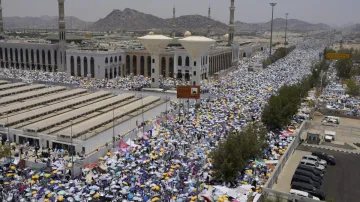Cairo: More than 1,000 people died during this year's annual Hajj pilgrimage in Saudi Arabia due to scorching-hot temperatures across the Islamic holy sites in the desert kingdom, according to officials. Over half of the fatalities were from Egypt, as the death count rose to 672 and 25 pilgrims were still reported missing, and a total of 236 Indonesians also died.
Earlier, the Ministry of External Affairs (MEA) had clarified that a total of 98 Indian pilgrims had died during the Hajj yatra in Saudi Arabia. "This year, we have 175,000 Indians who have already visited Hajj... So far, we have lost 98 of our citizens. These deaths have happened on account of natural illness, natural causes, chronic illness, and also old age. On the day of Arafat, six Indians died and four Indians died on account of accidents. Last year the figure of Indians who died in Hajj was 187..." said MEA spokesperson Randhir Jaiswal.
Further deaths were reported by Tunisia, Jordan, Iran, and Senegal, making this year's total toll at least 1,114 people, according to a Reuters tally. Saudi Arabia has not commented on the deaths during the pilgrimage, which is required of every able Muslim once in their life. Two pilgrims from the United States were also found dead.
Deaths are not uncommon at the Hajj, which witnesses millions of people travelling to Saudi Arabia for the five-day pilgrimage. It has also been the site of deadly stampedes and epidemics, such as the 2015 stampede in Mina which killed more than 2,400 pilgrims. The second-deadliest incident at the Hajj was a 1990 stampede that killed 1,426 people.
Unauthorised travel to Saudi Arabia from Egypt
Meanwhile, an Egyptian crisis unit tasked with investigating the situation said on Saturday it has suspended the licences of 16 tourism companies and referred them to the public prosecutor, accusing them of being responsible for deaths it said were mainly among pilgrims not registered under the official system.
The Egyptian government announced the death of 31 authorised pilgrims due to chronic diseases during this year’s Hajj, but didn’t offer an official tally for other pilgrims. However, a Cabinet official said that at least 630 other Egyptians died during the pilgrimage, with most reported at the Emergency Complex in Mecca’s Al-Muaisem neighborhood, most of whom have been buried in the country.
Saudi Arabian authorities had expelled tens and thousands of people, but most pilgrims from Egypt managed to reach holy sites, where they had no hotels to escape the scorching heat. The government said the travel agencies failed to provide adequate services for pilgrims and illegally facilitated their travel using visas that don't allow holders to travel to Mecca.
Scorching heatwaves across the world
It is worth mentioning that deadly heatwaves are scorching cities on four continents as the Northern Hemisphere marks the first day of summer, a sign that climate change may again help to fuel record-breaking heat that could surpass last summer as the warmest in 2,000 years. Record temperatures in recent days are suspected to have caused hundreds, if not thousands, of deaths across Asia and Europe.
In Saudi Arabia, temperatures soared above 46 degrees Celsius (117 degrees Fahrenheit) and 49 degrees Celsius (120 degrees Fahrenheit) in Mecca and sacred sites in and around the city, according to the Saudi National Center for Meteorology, causing some to faint while trying to perform the symbolic stoning of the devil.
The Hajj, one of the five pillars of Islam, is one of the world’s largest religious gatherings. More than 1.83 million Muslims performed the Hajj in 2024, including more than 1.6 million from 22 countries, and around 222,000 Saudi citizens and residents, according to the Saudi Hajj authorities.
What will happen in future pilgrimages?
Since Islam follows a lunar calendar, the Hajj takes place 11 days earlier each year, so the pilgrimage will held in April by 2029. A 2019 study by experts at the Massachusetts Institute of Technology found that even if the world succeeds in mitigating the worst effects of climate change, the Hajj would be held in temperatures exceeding an “extreme danger threshold” from 2047 to 2052, and from 2079 to 2086.
Countries around the Mediterranean have also endured another week of blistering high temperatures that have contributed to forest fires from Portugal to Greece and along the northern coast of Africa in Algeria, according to the US National Oceanic and Atmospheric Administration's Earth Observatory.
(with inputs from agencies)
ALSO READ | At least 98 Indian pilgrims die of heatstroke during hajj, MEA clarifies amid conflicting reports
Latest World News
